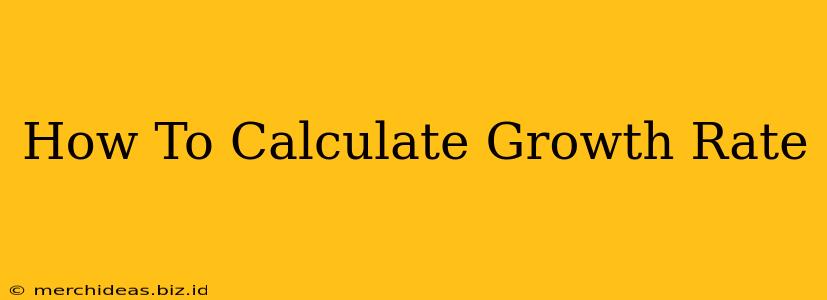Understanding growth rate is crucial for anyone tracking progress in business, finance, or even personal development. Whether you're analyzing company profits, investment returns, or personal fitness goals, knowing how to calculate growth rate provides valuable insights into trends and performance. This guide breaks down different methods for calculating growth rate, ensuring you can confidently analyze your data and make informed decisions.
Understanding Different Types of Growth Rates
Before diving into calculations, it's vital to understand the various types of growth rates you might encounter. The specific method you'll use depends on the data you have and the information you want to extract.
1. Simple Growth Rate:
This is the most basic method and suitable when you have only two data points – a starting value and an ending value. It simply shows the percentage change between these two points.
Formula: (Ending Value - Beginning Value) / Beginning Value * 100%
Example: If your sales increased from $10,000 to $12,000, the simple growth rate is: ($12,000 - $10,000) / $10,000 * 100% = 20%
This method is straightforward but doesn't account for compounding effects over multiple periods.
2. Compound Annual Growth Rate (CAGR):
CAGR is a more sophisticated method used to determine the average annual growth rate of an investment over a specified period, considering the effect of compounding. It smooths out fluctuations and provides a consistent picture of long-term growth.
Formula: [(Ending Value / Beginning Value)^(1 / Number of years)] - 1 * 100%
Example: If an investment grew from $10,000 to $16,105 over 5 years, the CAGR is: [($16,105 / $10,000)^(1/5)] - 1 * 100% ≈ 10% This means the investment grew at an average annual rate of 10%, taking into account compounding.
3. Average Annual Growth Rate (AAGR):
AAGR is similar to CAGR, but it's simpler and often used when dealing with less frequent data points (like annual data) where the assumption of continuous compounding may not be as accurate. AAGR is calculated as the arithmetic mean of the individual annual growth rates.
Formula: Sum of individual annual growth rates / Number of years
Example: If annual growth rates over three years were 5%, 10%, and 15%, the AAGR is (5% + 10% + 15%) / 3 = 10%.
Choosing the Right Method
The best method for calculating growth rate depends on your specific needs:
- Simple Growth Rate: Use for quick estimations with only two data points and where compounding isn't a significant factor.
- CAGR: Use for long-term investments or growth where compounding is important and you want a smoothed-out average growth rate.
- AAGR: Use when you have annual data and want a simple average annual growth, without the complexity of continuous compounding inherent in CAGR.
Practical Applications of Growth Rate Calculations
Growth rate calculations have a wide range of applications:
- Financial Analysis: Track investment returns, assess company performance, and predict future growth.
- Business Planning: Set realistic goals, measure progress, and make informed strategic decisions.
- Personal Finance: Monitor savings, investments, and debt reduction progress.
- Market Research: Analyze market trends, assess the growth potential of new products, and track competitor performance.
Mastering Growth Rate Calculations for Success
By understanding the nuances of different growth rate calculation methods, you equip yourself with powerful tools for analyzing data and making informed decisions across various aspects of life and business. Whether you're a seasoned investor, a budding entrepreneur, or simply aiming for personal improvement, mastering these techniques will significantly enhance your ability to track progress and plan for the future. Remember to choose the most appropriate method based on your data and objectives to obtain the most accurate and meaningful insights.
